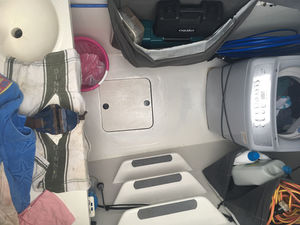
Issue #: 11
Published: August / September 2017
- Price per issue - digital : 6.50€Digital magazine
- Access to Multihulls World digital archives Digital archives
Once you’ve made the decision to do set off blue water cruising, a small question pings in the head of any sailor: how to avoid the breakdown that would have you stuck fast you at the far reaches of an inlet or in a port of the end of the world? And how not to blow the budget by keeping on top of boat maintenance? These two questions have the same answer: properly prepare your toolkit!
Every prospective blue water sailor is well aware that a multitude of lists must be prepared before the off, whether for an Atlantic circuit or a round the world trip. Clothing, cooking, medical supplies, fuel, ropes, sails, hardware, electronics, books, safety equipment, etc. are not to be neglected. But what you’ll need, to be able to use all this equipment and to intervene where necessary in every corner of the boat, is a decent onboard toolkit. For if a voyage is good - and fortunately for the majority of the time they are like we show you in the magazine, from a siesta in a hammock stretched between the mast and the bow in the shade of a sun awning in a dreamy anchorage, there is also some do-it-yourself to be done. And the maintenance and / or repairs on board during a trip, really is something you must not neglect! Like it or not, a boat is a machine which is technically very varied and complex. So it’s vital to carry a good selection of tools, and also to complete and adapt your toolkit to meet the requirements of your new environment.
Whoever can do the most can do the least, so you need to be able to carry out repairs on the motor, but also on rigging, fittings, electrical system, plumbing circuit and every piece of equipment on board. One can even imagine for the most gifted, adapting the interior, because on circumnavigation of several years when the boat is your home, improvements can be great. Finally, repairs to sails and awnings or on anchoring equipment will inevitably be required.

First off, you need to have a dedicated place on board for your basic tools and things you might need in a hurry. They’ve got to be within reach so you can react quickly, including when under way. Keep a drawer in the salon or have a cockpit locker where you can stow one or more toolbags which contain a few essentials: short handled screwdriver and extension with a selection of bits, including Allen key bits; adjustable wrench; ratchet with various sockets; a set of pliers: pipe wrench, mole grips, long-nosed pliers, cutters and electrical pliers; a hammer and a mallet; a hacksaw with good blades and a blade holder for sawing in difficult-access areas; a hand drill or a little 12V electric screwdriver with some good sharp drill bits, metal and wood; a set of files and a rasp; sandpaper, scissors, boxcutter; small electrical screwdriver and multimeter for diagnostics; tape measure; tube of superglue; insulation tape and waterproof tape.

On a long trip you can end up with real work to do, and a dedicated space is a big plus. On a catamaran there is often enough room to use part of a forward cabin as a workshop. It might possible to install a proper bench with a vise and shelves to store the spare equipment and racks to stow all your tools.

The most practical way to use tools on deck is to store them in a soft canvas, PVC or plastic toolbag (but certainly not a metal one, you won’t be able to open it ...
What readers think
Post a comment
No comments to show.